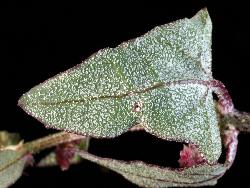- Taxon
- Gallery
- = Chenopodium album subsp. amaranticolor H.J.Coste & A.Reyn.
- ≡ Chenopodium amaranticolor (H.J.Coste & A.Reyn.) H.J.Coste & A.Reyn.
- = Chenopodium probstii Aellen (1928)
Erect or spreading, simple or branched, green or grey-farinose, sometimes reddish tinged, eglandular, non-aromatic, annual herb. Stems (2)–5–200 cm tall. Petiole usually 1–1.5× lamina; lamina extremely variable, usually 1.5–7 × 1–4 cm, lanceolate to ovate, rhombic or triangular, entire to coarsely serrate-dentate, rarely slightly 3-lobed; base usually cuneate, sometimes rounded or truncate; farina when present denser beneath, sometimes purple-tinged on young lvs, very rarely lamina bright green. Infls paniculate, sometimes very narrow, terminal and axillary, to c. 30 cm long, lacking subtending lvs in upper part, simple in depauperate plants, otherwise spicately branched; glomerules c. 8-flowered, dense or interrupted, ± farinose. Fls usually in dense panicles, sessile or subsessile. Perianth segments 0.5–2.5–(3) × 0.6–1 mm, broad and imbricate, accrescent; keel obtuse, green; margins broadly hyaline. Fr. completely invested by perianth; pericarp easily removed. Seed horizontal, (1.0)–1.1–1.4–(1.6) mm diam., flattened, circular, glossy black, generally smooth except for faint striations; keel obtuse.
[From: Webb et al. (1988) Flora of New Zealand. Volume 4.]
Flowering: Dec.–May.




